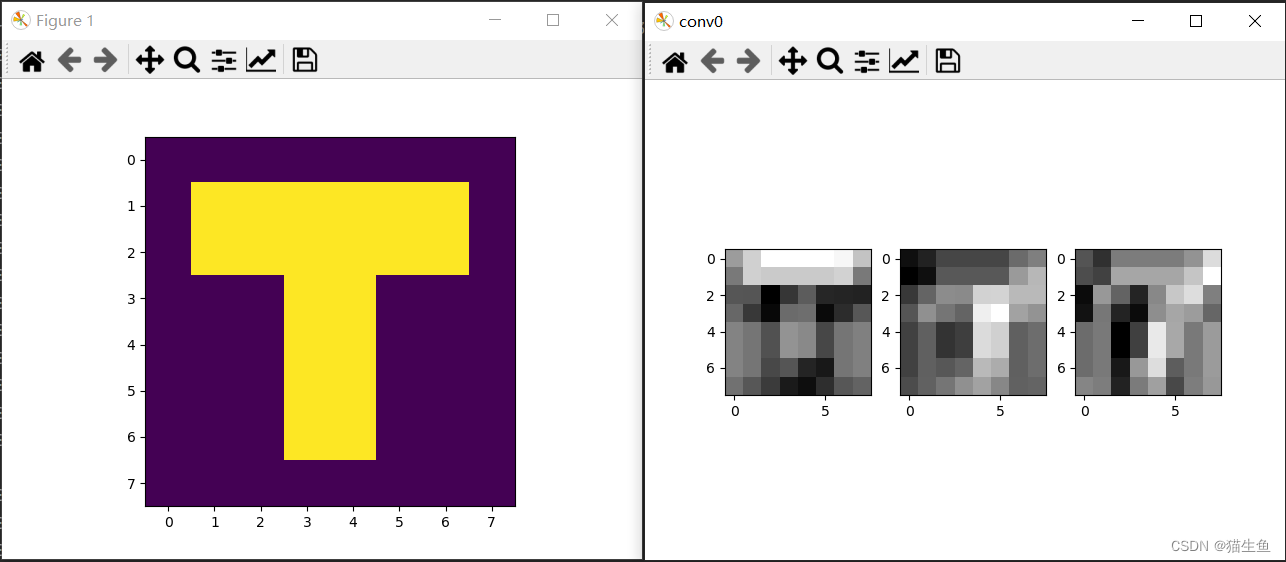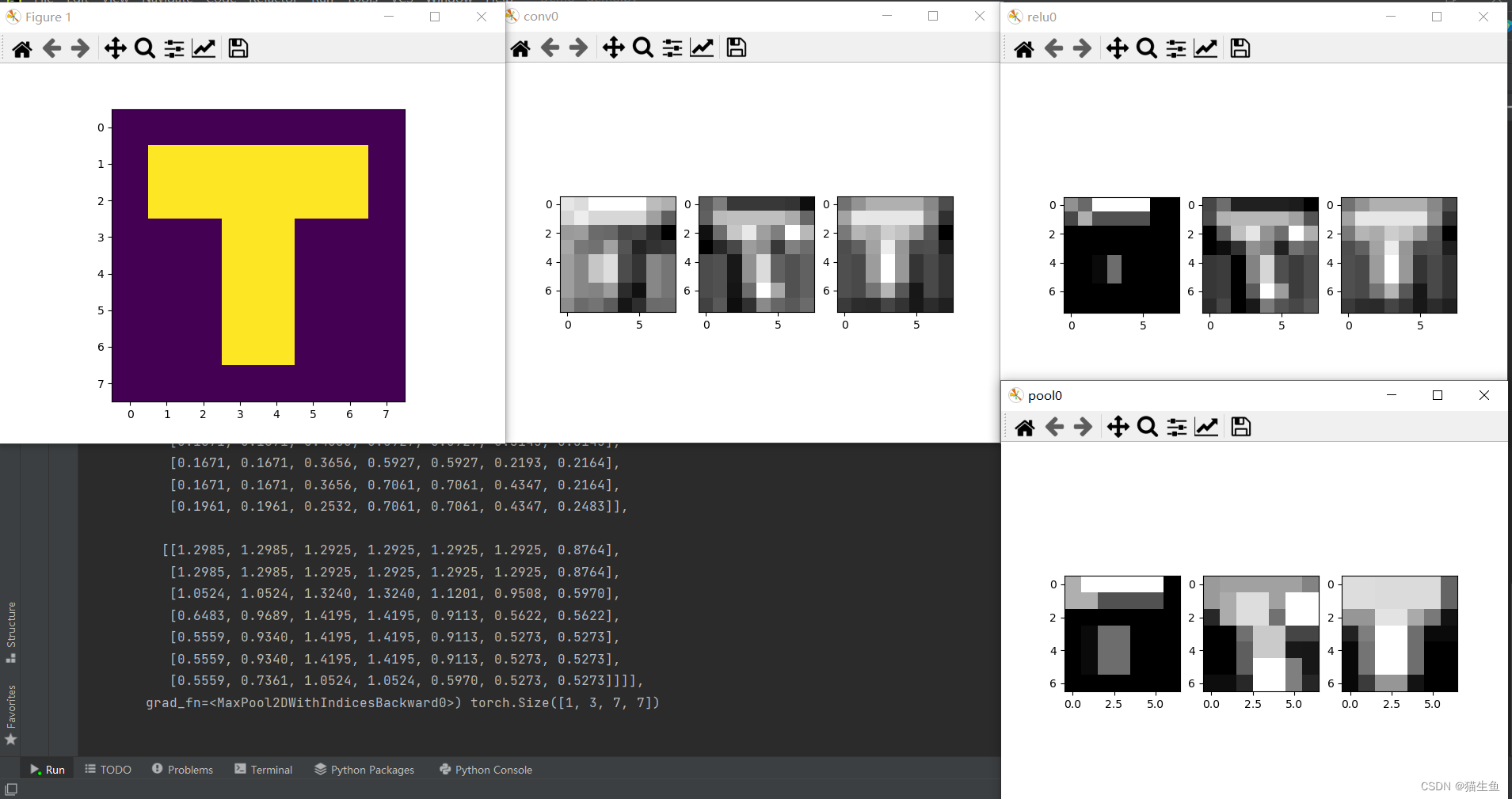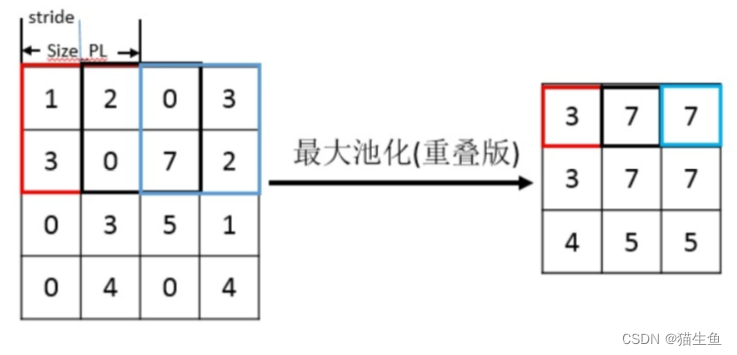理解深度学习的卷积层、激活层、池化层
网上看了些教程,感觉还是来点实例可能更好理解一些。
下面分别把卷积层nn.Conv2d()、激活层nn.ReLU()、池化层nn.MaxPool2d()用代码表示出来,并且用图片显示加以理解。
读取图片
先读取一张图片,用来做卷积等操作的示范。
用cv2来读取读片,并转换成深度学习网络可使用的数据格式。
因为神经网络中有一个batch size的功能,但我们只有一张图片,所以需要image.unsqueeze(0) 一下增加一个数量
# 将图片转换为模型可用的数据
def getImageData(imgFile):
image = cv2.imread(imgFile, 0)
image = F.to_tensor(image) # shape为 [1, 768, 1024], [通道,高,宽]
image = image.unsqueeze(0) # shape为 [1, 1, 768, 1024], [数量,通道,高,宽]
return image
显示图片
在图片做完卷积、激活、池化后,需要将图片显示出来,用来观察这些操作到底做了什么事情。
显示图片,用的是matplotlib.pyplot。
这里只显示三个图片做示例。
# 将三个图片显示在plt上
def showTensorImg(image, title=""):
plt.figure(title) # 创建第一个图形
plt.sca(plt.subplot(1, 3, 1)) # 分成1行2列,选择第1个位置
plt.imshow(image[0].data, cmap=plt.cm.gray)
plt.sca(plt.subplot(1, 3, 2)) # 分成1行2列,选择第2个位置
plt.imshow(image[1].data, cmap=plt.cm.gray)
plt.sca(plt.subplot(1, 3, 3)) # 分成1行2列,选择第2个位置
plt.imshow(image[2].data, cmap=plt.cm.gray)
定义一个神经网络
用一个神经网络,在其中加入卷积层。
这里构建网络,用的是pytorch的 torch.nn。
# 定义模型
class MyModel(nn.Module):
def __init__(self):
super(MyModel, self).__init__()
self.conv0 = nn.Conv2d(in_channels=1, out_channels=3, kernel_size=(3, 3), stride=1, padding=1)
# 把模型里的卷积层和激活层后的效果,显示出来看一看
def forward(self, image):
img = self.conv0(image)
print("conv0:", img, img.shape, "\n")
showTensorImg(img.squeeze(), "conv0")
return img
查看卷积层结果
拿一张图片来做示范,先显示原图,再显示卷积层的结果。
if __name__ == "__main__":
# 显示原图
img = cv2.imread("Data/2.jpeg", 0)
plt.imshow(img)
print(img.shape)
net = MyModel()
image = getImageData("Data/2.jpeg")
img = net(image)
plt.show()
看看显示结果:

看看输出结果:
(8, 8)
conv0: tensor([[[[ 0.4108, 0.6527, 0.8689, 0.8689, 0.8689, 0.8689, 0.8303, 0.5918],
[ 0.2540, 0.6494, 0.6211, 0.6211, 0.6211, 0.6211, 0.6613, 0.2530],
[ 0.0873, 0.0837, -0.3083, -0.0584, 0.1192, -0.1307, -0.1400, -0.1493],
[ 0.1661, -0.0434, -0.2697, 0.1860, 0.1980, -0.2577, -0.1014, 0.0951],
[ 0.2942, 0.2339, 0.0656, 0.3721, 0.3261, 0.0195, 0.2339, 0.2812],
[ 0.2942, 0.2339, 0.0656, 0.3721, 0.3261, 0.0195, 0.2339, 0.2812],
[ 0.2942, 0.2339, 0.0270, 0.0837, -0.1400, -0.1967, 0.2339, 0.2812],
[ 0.2130, 0.0919, -0.0362, -0.1854, -0.2434, -0.0942, 0.0919, 0.1501]],
[[-0.4264, -0.3058, -0.0771, -0.0771, -0.0771, -0.0771, 0.1542, 0.2827],
[-0.5278, -0.4299, 0.0381, 0.0381, 0.0381, 0.0381, 0.4555, 0.6393],
[-0.1677, 0.1134, 0.3660, 0.3549, 0.8149, 0.8260, 0.6546, 0.6552],
[ 0.0183, 0.3910, 0.2182, 0.1155, 1.0009, 1.1036, 0.5068, 0.4159],
[-0.1105, 0.0901, -0.1985, -0.1290, 0.8722, 0.8027, 0.0901, 0.1713],
[-0.1105, 0.0901, -0.1985, -0.1290, 0.8722, 0.8027, 0.0901, 0.1713],
[-0.1105, 0.0901, 0.0328, 0.1134, 0.6546, 0.5740, 0.0901, 0.1713],
[-0.0422, 0.0939, 0.2227, 0.3948, 0.5107, 0.3385, 0.0939, 0.1101]],
[[-0.0304, -0.1294, 0.0825, 0.0825, 0.0825, 0.0825, 0.1528, 0.3564],
[-0.0499, -0.0802, 0.2031, 0.2031, 0.2031, 0.2031, 0.2914, 0.4559],
[-0.2361, 0.1632, 0.0132, -0.1656, 0.1166, 0.2954, 0.3580, 0.0929],
[-0.2182, 0.0699, -0.1696, -0.2371, 0.1346, 0.2021, 0.1752, 0.0214],
[ 0.0384, 0.0756, -0.2692, -0.0859, 0.3911, 0.2077, 0.0756, 0.1726],
[ 0.0384, 0.0756, -0.2692, -0.0859, 0.3911, 0.2077, 0.0756, 0.1726],
[ 0.0384, 0.0756, -0.1989, 0.1632, 0.3580, -0.0041, 0.0756, 0.1726],
[ 0.1085, 0.0860, -0.1705, 0.0804, 0.1857, -0.0651, 0.0860, 0.1633]]]],
grad_fn=<ThnnConv2DBackward0>) torch.Size([1, 3, 8, 8])
我的输入是图片的灰度单通道,但经过卷积后可以输出3通道甚至更多。
再看输出的shape,图片宽高均为(8,8),没有改变。
卷积的原理:

(图片我是从这里搬过来的,感谢作者!)
卷积核为(3,3),每(3,3)的方块中通过卷积运算得到一个像素值。因为在卷积时使用了一个padding=1,所以在原图四周多出一个像素,也就导致卷积图和原图保持同一个大小。
卷积的原理看这儿。
神经网络中添加一个激活层
这里使用的激活函数为nn.ReLU(),先添加运行看看结果。
# 定义模型
class MyModel(nn.Module):
def __init__(self):
super(MyModel, self).__init__()
self.conv0 = nn.Conv2d(in_channels=1, out_channels=3, kernel_size=(3, 3), stride=1, padding=1)
self.relu0 = nn.ReLU(inplace=True)
# 把模型里的卷积层和激活层后的效果,显示出来看一看
def forward(self, image):
img = self.conv0(image)
print("conv0:", img, img.shape, "\n")
showTensorImg(img.squeeze(), "conv0")
img = self.relu0(img)
print("relu0:", img, img.shape, "\n")
showTensorImg(img.squeeze(), "relu0")
return img

再看看输出结果:
(8, 8)
conv0: tensor([[[[-0.4327, -0.4364, -0.5815, -0.5815, -0.5815, -0.5815, -0.3790, -0.3967],
[-0.1099, -0.2190, -0.2511, -0.2511, -0.2511, -0.2511, -0.2947, -0.2357],
[ 0.2893, 0.2509, 0.2563, 0.2617, 0.3190, 0.3136, 0.0159, 0.0043],
[ 0.0433, 0.1370, 0.2754, 0.1487, 0.0730, 0.1997, 0.0351, -0.1086],
[-0.1535, -0.1358, 0.1045, 0.0538, -0.1238, -0.0732, -0.1358, -0.2035],
[-0.1535, -0.1358, 0.1045, 0.0538, -0.1238, -0.0732, -0.1358, -0.2035],
[-0.1535, -0.1358, 0.3070, 0.2509, 0.0159, 0.0720, -0.1358, -0.2035],
[-0.0980, -0.0395, 0.1572, 0.2333, 0.1314, 0.0553, -0.0395, -0.1642]],
[[-0.2516, -0.4649, -0.5853, -0.5853, -0.5853, -0.5853, -0.6295, -0.4837],
[-0.1780, -0.2942, -0.4109, -0.4109, -0.4109, -0.4109, -0.5343, -0.4370],
[-0.4042, -0.1781, -0.1395, -0.3199, -0.4845, -0.3040, -0.0809, -0.3259],
[-0.4835, -0.3571, -0.2429, -0.3237, -0.5638, -0.4830, -0.1843, -0.3296],
[-0.3014, -0.3369, -0.3955, -0.3145, -0.3818, -0.4628, -0.3369, -0.3204],
[-0.3014, -0.3369, -0.3955, -0.3145, -0.3818, -0.4628, -0.3369, -0.3204],
[-0.3014, -0.3369, -0.4396, -0.1781, -0.0809, -0.3423, -0.3369, -0.3204],
[-0.2631, -0.2646, -0.4467, -0.2849, -0.1120, -0.2739, -0.2646, -0.2357]],
[[ 0.5655, 0.6888, 0.4497, 0.4497, 0.4497, 0.4497, 0.3205, 0.0511],
[ 0.6213, 0.8629, 0.5083, 0.5083, 0.5083, 0.5083, 0.3436, 0.0312],
[ 0.3276, 0.5826, 0.6993, 0.9224, 0.5541, 0.3310, 0.6991, 0.3734],
[ 0.2920, 0.4577, 0.7255, 1.0379, 0.5186, 0.2062, 0.7253, 0.4888],
[ 0.4566, 0.3858, 0.3860, 0.9348, 0.6831, 0.1342, 0.3858, 0.3858],
[ 0.4566, 0.3858, 0.3860, 0.9348, 0.6831, 0.1342, 0.3858, 0.3858],
[ 0.4566, 0.3858, 0.2568, 0.5826, 0.6991, 0.3734, 0.3858, 0.3858],
[ 0.3575, 0.3540, 0.1894, 0.4259, 0.6935, 0.4570, 0.3540, 0.3903]]]],
grad_fn=<ThnnConv2DBackward0>) torch.Size([1, 3, 8, 8])
relu0: tensor([[[[0.0000, 0.0000, 0.0000, 0.0000, 0.0000, 0.0000, 0.0000, 0.0000],
[0.0000, 0.0000, 0.0000, 0.0000, 0.0000, 0.0000, 0.0000, 0.0000],
[0.2893, 0.2509, 0.2563, 0.2617, 0.3190, 0.3136, 0.0159, 0.0043],
[0.0433, 0.1370, 0.2754, 0.1487, 0.0730, 0.1997, 0.0351, 0.0000],
[0.0000, 0.0000, 0.1045, 0.0538, 0.0000, 0.0000, 0.0000, 0.0000],
[0.0000, 0.0000, 0.1045, 0.0538, 0.0000, 0.0000, 0.0000, 0.0000],
[0.0000, 0.0000, 0.3070, 0.2509, 0.0159, 0.0720, 0.0000, 0.0000],
[0.0000, 0.0000, 0.1572, 0.2333, 0.1314, 0.0553, 0.0000, 0.0000]],
[[0.0000, 0.0000, 0.0000, 0.0000, 0.0000, 0.0000, 0.0000, 0.0000],
[0.0000, 0.0000, 0.0000, 0.0000, 0.0000, 0.0000, 0.0000, 0.0000],
[0.0000, 0.0000, 0.0000, 0.0000, 0.0000, 0.0000, 0.0000, 0.0000],
[0.0000, 0.0000, 0.0000, 0.0000, 0.0000, 0.0000, 0.0000, 0.0000],
[0.0000, 0.0000, 0.0000, 0.0000, 0.0000, 0.0000, 0.0000, 0.0000],
[0.0000, 0.0000, 0.0000, 0.0000, 0.0000, 0.0000, 0.0000, 0.0000],
[0.0000, 0.0000, 0.0000, 0.0000, 0.0000, 0.0000, 0.0000, 0.0000],
[0.0000, 0.0000, 0.0000, 0.0000, 0.0000, 0.0000, 0.0000, 0.0000]],
[[0.5655, 0.6888, 0.4497, 0.4497, 0.4497, 0.4497, 0.3205, 0.0511],
[0.6213, 0.8629, 0.5083, 0.5083, 0.5083, 0.5083, 0.3436, 0.0312],
[0.3276, 0.5826, 0.6993, 0.9224, 0.5541, 0.3310, 0.6991, 0.3734],
[0.2920, 0.4577, 0.7255, 1.0379, 0.5186, 0.2062, 0.7253, 0.4888],
[0.4566, 0.3858, 0.3860, 0.9348, 0.6831, 0.1342, 0.3858, 0.3858],
[0.4566, 0.3858, 0.3860, 0.9348, 0.6831, 0.1342, 0.3858, 0.3858],
[0.4566, 0.3858, 0.2568, 0.5826, 0.6991, 0.3734, 0.3858, 0.3858],
[0.3575, 0.3540, 0.1894, 0.4259, 0.6935, 0.4570, 0.3540, 0.3903]]]],
grad_fn=<ReluBackward0>) torch.Size([1, 3, 8, 8])
从输出的结果可以看到,nn.ReLU()激活函数,将卷积的结果图片中,所有小于0的值被被置零了,并不会改变图片的大小。
因为值越大,特征就越是突出,那将小于0的值全部抹掉,可以减少模型的计算。
神经网络中添加一个池化层
这里池化层用的是最大池化,nn.MaxPool2d(),平均池化的话可以自己尝试一下。
# 定义模型
class MyModel(nn.Module):
def __init__(self):
super(MyModel, self).__init__()
self.conv0 = nn.Conv2d(in_channels=1, out_channels=3, kernel_size=(3, 3), stride=1, padding=1)
self.relu0 = nn.ReLU(inplace=True)
self.pool0 = nn.MaxPool2d(kernel_size=2, stride=1)
# 把模型里的卷积层和激活层后的效果,显示出来看一看
def forward(self, image):
img = self.conv0(image)
print("conv0:", img, img.shape, "\n")
showTensorImg(img.squeeze(), "conv0")
img = self.relu0(img)
print("relu0:", img, img.shape, "\n")
showTensorImg(img.squeeze(), "relu0")
img = self.pool0(img)
print("pool0:", img, img.shape, "\n")
showTensorImg(img.squeeze(), "pool0")
return img

输出结果:
D:\ProgramData\anaconda3\envs\Python3.8.5-Pytorch\python.exe E:/work/Python/Demo/demo.py
(8, 8)
conv0: tensor([[[[ 0.1296, 0.0942, 0.2273, 0.2273, 0.2273, 0.2273, -0.0275, -0.0733],
[ 0.0647, 0.1555, 0.0734, 0.0734, 0.0734, 0.0734, -0.1328, -0.3786],
[-0.1575, -0.1451, -0.3350, -0.3473, -0.4690, -0.4568, -0.5740, -0.7413],
[-0.1089, -0.2873, -0.3107, -0.1321, -0.4204, -0.5990, -0.5496, -0.5262],
[-0.1416, -0.2293, 0.0097, 0.0975, -0.4531, -0.5410, -0.2293, -0.2965],
[-0.1416, -0.2293, 0.0097, 0.0975, -0.4531, -0.5410, -0.2293, -0.2965],
[-0.1416, -0.2293, -0.2452, -0.1451, -0.5740, -0.6741, -0.2293, -0.2965],
[-0.2099, -0.3350, -0.3023, -0.3930, -0.6554, -0.5647, -0.3350, -0.3305]],
[[ 0.1986, 0.3047, 0.0893, 0.0893, 0.0893, 0.0893, 0.0789, -0.0405],
[ 0.2143, 0.4924, 0.5072, 0.5072, 0.5072, 0.5072, 0.4453, 0.2312],
[-0.0329, 0.2532, 0.5312, 0.6332, 0.4074, 0.3054, 0.7061, 0.4840],
[-0.0843, 0.0403, 0.1396, 0.4030, 0.3559, 0.0925, 0.3145, 0.2538],
[ 0.1525, 0.1671, -0.0078, 0.3656, 0.5927, 0.2193, 0.1671, 0.2164],
[ 0.1525, 0.1671, -0.0078, 0.3656, 0.5927, 0.2193, 0.1671, 0.2164],
[ 0.1525, 0.1671, -0.0182, 0.2532, 0.7061, 0.4347, 0.1671, 0.2164],
[ 0.1208, 0.1961, -0.0406, 0.0693, 0.3435, 0.2335, 0.1961, 0.2483]],
[[ 0.7197, 0.8873, 1.0323, 1.0323, 1.0323, 1.0323, 0.8345, 0.5481],
[ 0.9719, 1.2985, 1.2925, 1.2925, 1.2925, 1.2925, 0.8764, 0.4069],
[ 0.7647, 1.0524, 1.0036, 1.1729, 1.1201, 0.9508, 0.5970, 0.1663],
[ 0.5465, 0.6483, 0.9689, 1.3240, 0.9019, 0.5468, 0.5622, 0.3174],
[ 0.5559, 0.5273, 0.9340, 1.4195, 0.9113, 0.4258, 0.5273, 0.4129],
[ 0.5559, 0.5273, 0.9340, 1.4195, 0.9113, 0.4258, 0.5273, 0.4129],
[ 0.5559, 0.5273, 0.7361, 1.0524, 0.5970, 0.2807, 0.5273, 0.4129],
[ 0.4526, 0.3832, 0.3738, 0.5042, 0.4181, 0.2877, 0.3832, 0.3244]]]],
grad_fn=<ThnnConv2DBackward0>) torch.Size([1, 3, 8, 8])
relu0: tensor([[[[0.1296, 0.0942, 0.2273, 0.2273, 0.2273, 0.2273, 0.0000, 0.0000],
[0.0647, 0.1555, 0.0734, 0.0734, 0.0734, 0.0734, 0.0000, 0.0000],
[0.0000, 0.0000, 0.0000, 0.0000, 0.0000, 0.0000, 0.0000, 0.0000],
[0.0000, 0.0000, 0.0000, 0.0000, 0.0000, 0.0000, 0.0000, 0.0000],
[0.0000, 0.0000, 0.0097, 0.0975, 0.0000, 0.0000, 0.0000, 0.0000],
[0.0000, 0.0000, 0.0097, 0.0975, 0.0000, 0.0000, 0.0000, 0.0000],
[0.0000, 0.0000, 0.0000, 0.0000, 0.0000, 0.0000, 0.0000, 0.0000],
[0.0000, 0.0000, 0.0000, 0.0000, 0.0000, 0.0000, 0.0000, 0.0000]],
[[0.1986, 0.3047, 0.0893, 0.0893, 0.0893, 0.0893, 0.0789, 0.0000],
[0.2143, 0.4924, 0.5072, 0.5072, 0.5072, 0.5072, 0.4453, 0.2312],
[0.0000, 0.2532, 0.5312, 0.6332, 0.4074, 0.3054, 0.7061, 0.4840],
[0.0000, 0.0403, 0.1396, 0.4030, 0.3559, 0.0925, 0.3145, 0.2538],
[0.1525, 0.1671, 0.0000, 0.3656, 0.5927, 0.2193, 0.1671, 0.2164],
[0.1525, 0.1671, 0.0000, 0.3656, 0.5927, 0.2193, 0.1671, 0.2164],
[0.1525, 0.1671, 0.0000, 0.2532, 0.7061, 0.4347, 0.1671, 0.2164],
[0.1208, 0.1961, 0.0000, 0.0693, 0.3435, 0.2335, 0.1961, 0.2483]],
[[0.7197, 0.8873, 1.0323, 1.0323, 1.0323, 1.0323, 0.8345, 0.5481],
[0.9719, 1.2985, 1.2925, 1.2925, 1.2925, 1.2925, 0.8764, 0.4069],
[0.7647, 1.0524, 1.0036, 1.1729, 1.1201, 0.9508, 0.5970, 0.1663],
[0.5465, 0.6483, 0.9689, 1.3240, 0.9019, 0.5468, 0.5622, 0.3174],
[0.5559, 0.5273, 0.9340, 1.4195, 0.9113, 0.4258, 0.5273, 0.4129],
[0.5559, 0.5273, 0.9340, 1.4195, 0.9113, 0.4258, 0.5273, 0.4129],
[0.5559, 0.5273, 0.7361, 1.0524, 0.5970, 0.2807, 0.5273, 0.4129],
[0.4526, 0.3832, 0.3738, 0.5042, 0.4181, 0.2877, 0.3832, 0.3244]]]],
grad_fn=<ReluBackward0>) torch.Size([1, 3, 8, 8])
pool0: tensor([[[[0.1555, 0.2273, 0.2273, 0.2273, 0.2273, 0.2273, 0.0000],
[0.1555, 0.1555, 0.0734, 0.0734, 0.0734, 0.0734, 0.0000],
[0.0000, 0.0000, 0.0000, 0.0000, 0.0000, 0.0000, 0.0000],
[0.0000, 0.0097, 0.0975, 0.0975, 0.0000, 0.0000, 0.0000],
[0.0000, 0.0097, 0.0975, 0.0975, 0.0000, 0.0000, 0.0000],
[0.0000, 0.0097, 0.0975, 0.0975, 0.0000, 0.0000, 0.0000],
[0.0000, 0.0000, 0.0000, 0.0000, 0.0000, 0.0000, 0.0000]],
[[0.4924, 0.5072, 0.5072, 0.5072, 0.5072, 0.5072, 0.4453],
[0.4924, 0.5312, 0.6332, 0.6332, 0.5072, 0.7061, 0.7061],
[0.2532, 0.5312, 0.6332, 0.6332, 0.4074, 0.7061, 0.7061],
[0.1671, 0.1671, 0.4030, 0.5927, 0.5927, 0.3145, 0.3145],
[0.1671, 0.1671, 0.3656, 0.5927, 0.5927, 0.2193, 0.2164],
[0.1671, 0.1671, 0.3656, 0.7061, 0.7061, 0.4347, 0.2164],
[0.1961, 0.1961, 0.2532, 0.7061, 0.7061, 0.4347, 0.2483]],
[[1.2985, 1.2985, 1.2925, 1.2925, 1.2925, 1.2925, 0.8764],
[1.2985, 1.2985, 1.2925, 1.2925, 1.2925, 1.2925, 0.8764],
[1.0524, 1.0524, 1.3240, 1.3240, 1.1201, 0.9508, 0.5970],
[0.6483, 0.9689, 1.4195, 1.4195, 0.9113, 0.5622, 0.5622],
[0.5559, 0.9340, 1.4195, 1.4195, 0.9113, 0.5273, 0.5273],
[0.5559, 0.9340, 1.4195, 1.4195, 0.9113, 0.5273, 0.5273],
[0.5559, 0.7361, 1.0524, 1.0524, 0.5970, 0.5273, 0.5273]]]],
grad_fn=<MaxPool2DWithIndicesBackward0>) torch.Size([1, 3, 7, 7])
可以看到,经过池化层之后原本(8,8)大小的图片,变成了(7,7)。
池化层到底是什么,是为了在一定区域内提取出该区域的关键性信息,起到减少卷积层输出特征量数目的作用,从而能减少模型参数,同时能改善过拟合现象。
虽然图片大小变小了,但关键信息却被提取了出来,还能减少模型计算量。
池化层的原理,例如我的池化层设定是nn.MaxPool2d(kernel_size=2, stride=1),那么池化层的窗口就为(2,2),以(2,2)的窗口,在图片中从左往右从上往下移动,每移动步长stride为1。在每个(2,2)的窗口中,寻找其最大值,作为新图片的像素值。

(图片来源在这里,感谢作者!)
全部代码
from torchvision.transforms import functional as F
import matplotlib.pyplot as plt
import torch.nn as nn
import cv2
# 将图片转换为模型可用的数据
def getImageData(imgFile):
image = cv2.imread(imgFile, 0)
image = F.to_tensor(image) # shape为 [1, 768, 1024], [通道,高,宽]
image = image.unsqueeze(0) # shape为 [1, 1, 768, 1024], [数量,通道,高,宽]
return image
# 将三个图片显示在plt上
def showTensorImg(image, title=""):
plt.figure(title) # 创建第一个图形
plt.sca(plt.subplot(1, 3, 1)) # 分成1行2列,选择第1个位置
plt.imshow(image[0].data, cmap=plt.cm.gray)
plt.sca(plt.subplot(1, 3, 2)) # 分成1行2列,选择第2个位置
plt.imshow(image[1].data, cmap=plt.cm.gray)
plt.sca(plt.subplot(1, 3, 3)) # 分成1行2列,选择第2个位置
plt.imshow(image[2].data, cmap=plt.cm.gray)
# 定义模型
class MyModel(nn.Module):
def __init__(self):
super(MyModel, self).__init__()
self.conv0 = nn.Conv2d(in_channels=1, out_channels=3, kernel_size=(3, 3), stride=1, padding=1)
self.relu0 = nn.ReLU(inplace=True)
self.pool0 = nn.MaxPool2d(kernel_size=2, stride=1)
# 把模型里的卷积层和激活层后的效果,显示出来看一看
def forward(self, image):
img = self.conv0(image)
print("conv0:", img, img.shape, "\n")
showTensorImg(img.squeeze(), "conv0")
img = self.relu0(img)
print("relu0:", img, img.shape, "\n")
showTensorImg(img.squeeze(), "relu0")
img = self.pool0(img)
print("pool0:", img, img.shape, "\n")
showTensorImg(img.squeeze(), "pool0")
return img
if __name__ == "__main__":
# 显示原图
img = cv2.imread("Data/T.bmp", 0)
plt.imshow(img)
print(img.shape)
net = MyModel()
image = getImageData("Data/T.bmp")
img = net(image)
plt.show()























 1730
1730











 被折叠的 条评论
为什么被折叠?
被折叠的 条评论
为什么被折叠?








